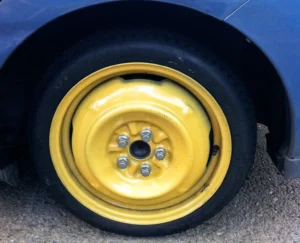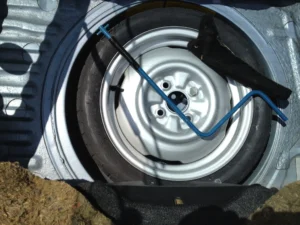Have you ever Stopped on the side of the road with a flat tire? It’s not a fun experience. While swapping in your spare tire can get you back on the road, you may be wondering—How Far Can You Drive on a Spare Tire?
I’ve been there before. Trying to get my sick cat to the vet on a donut spare, driving hunched over the wheel like Ms. Frizzle from the Magic School Bus. Not my finest moment.
But you’re not alone! In this complete guide, we’ll cover everything you need to know about driving on a spare tire, including:
- How far you can drive
- The truth about highway driving on a spare
- What happens if you go too far
- Types of spare tires and their restrictions
- Safe driving tips and precautions
- When and why do you need to replace your spare
- And answers to some frequently asked questions
So let’s get rolling with the basics…
The Short Answer: 50 Miles Max
I know I know—you wish you could zip hundreds of miles to your destination on that little temporary spare tire. But here’s the blunt truth:
You should not drive more than 50 miles on a temporary or donut spare tire.
Driving further risks damage to your vehicle or a dangerous blowout. I’ll explain why coming up.
If you absolutely must go further than 50 miles, don’t drive on a small spare for more than 70 miles total.
You’re pushing your luck at that point. A spare is made for short trips to a tire shop, not cross-country road trips!
Highway Driving? Not Recommended!
Many drivers wonder—can I hop on the interstate with my donut spare?
I don’t recommend it. Here’s why:
It would help if you didn’t drive faster than 50 mph on a temporary spare or donut tire.
These tires lack traction and aren’t built for high speeds over long distances. Driving too fast increases the risk of spin-outs, hydroplaning, and crashes. It’s just not worth it!
Instead, stick to slower side roads and limit highway driving to the bare minimum distance to exit near a tire shop.
And speaking of high speeds…
What Happens If You Go Too Far?
How Far Can You Drive on a Spare Tire? Let’s say you push your little spare tire to the limit, driving it for 100+ miles on the freeway. What could happen?
Well, a few unpleasant things:
- Blowouts: The tire could violently blow out or come apart at high speeds. This can damage your car and cause you to lose control.
- Transmission wear: The size difference between spare and normal tires can damage drivetrain components like CV joints.
- Hydroplaning: Bald, narrow spares lose traction very easily on wet roads, increasing hydroplaning risk.
- ABS/Speedometer issues: The spare may trigger ABS or speedometer errors, impacting brake and speed performance.
Bottom line—don’t use that tiny spare as a permanent replacement! Time for a tire shop ASAP.
Now that you know the limits, let’s break down the different types of spares and their restrictions…
Spare Tire Types and Restrictions
How Far Can You Drive on a Spare Tire? There are a few main kinds of spare tires your car might have:
Compact/Donut Spare

- Also called a “space-saver” or “temporary” spare
- Much smaller than a standard tire
- Usually found in cars and small SUVs
- Speed limit ~50 mph
- Drive up to 50 miles max before replacement
Full-Size Spare

- Same overall size as normal tires
- More common on larger vehicles like trucks & SUVs
- Can drive at normal speeds
- Still safer to replace ASAP
Run-Flat Tires

- Reinforced to resist punctures
- Can drive ~50 miles at 50 mph after a puncture
- Get them inspected and replaced ASAP if pressure loss occurs
As you can see, restrictions vary based on spare tire type and size. Check your owner’s manual or the markings on the tire itself to determine safe driving limits.
Top Tips for Safe Driving on a Spare
How Far Can You Drive on a Spare Tire? Got that donut mounted and ready to roll? Here are my top safety tips for driving on a temporary spare tire:
✅ Mind the max speed and mileage limits based on your spare type to avoid vehicle damage or blowouts. Be extra cautious on the highway.
✅ Watch your following distance. Spares may trigger ABS or speedometer inaccuracies, impacting braking. Leave ample room to break gradually.
✅ Go slow in rain/snow. Bald, narrow spares hydroplane easily on wet roads. Reduce speed and increase stopping distance.
✅ Check spare tire pressure before installing. Proper inflation is key! Donut spares often need more pressure than regular tires.
✅ Get that tire replaced ASAP! The spare is temporary for a reason. Schedule a tire shop visit right away.
Driving cautiously and limiting mileage/speed can help you safely drive a spare to get repairs. But it’s not meant for extensive driving!
When to Replace Your Spare Tire
So when does that spare tire finally need to be swapped out?
- Donut spares should be replaced after around 6-8 years regardless of wear. The rubber breaks down over time.
- Full-size spares need replacement if worn, damaged, or over 10 years old.
- Run-flats require replacement after any puncture.
Check your owner’s manual for specific spare replacement intervals. And don’t forget to…
🔄 Rotate your full-size spare into the regular tire rotation now and then to keep it functional!
FAQs: How Far Can You Drive on a Spare Tire?
Let’s wrap up this spare tire deep dive by answering some frequently asked questions:
How long can you drive with a temporary spare tire?
You should go no more than 50 miles at 50 mph on a small temporary spare before replacement. Any further risks of damage or blowouts.
Can I drive long distances on a full-size spare?
You can drive further on a full-size spare since it’s the same overall size. But it’s still best to replace it soon for safety, as the tread may differ.
Is it OK to drive on a spare tire for 2 weeks/a month?
It’s not recommended. Temporary spares like donuts are meant for short trips to a tire shop. Use a full-size spare if waiting weeks for replacement.
How many kilometers can you drive on a space-saver spare?
Donut and space-saver spares should be driven 80 km (50 miles) or less before replacement. Exceeding this risks vehicle damage and hazardous driving.
What’s the difference between a spare and a normal tire?
Spares are smaller or differently treated. Restrictions prevent long-term use. Normal tires are designed for extensive driving.
What PSI should my spare tire be inflated to?
Spare tire PSI requirements vary. They often need more pressure than a normal tire, even up to 60 PSI. Always check manufacturer guidelines.
The Bottom Line – How Far Can You Drive on a Spare Tire?
There you have it—everything you need to know about How Far Can You Drive on a Spare Tire!
While that little donut can get you to the next exit in a pinch, please take it slow and get it replaced as soon as possible. Spares should only be used for short distances before you risk damage or hazardous handling.
And if you ever need new tires (or even just an air pressure check!), your local tire shop is always here to help. Just maybe leave the Ms. Frizzle driving antics at home next time.

